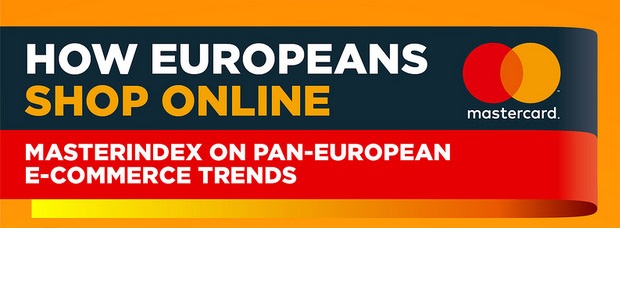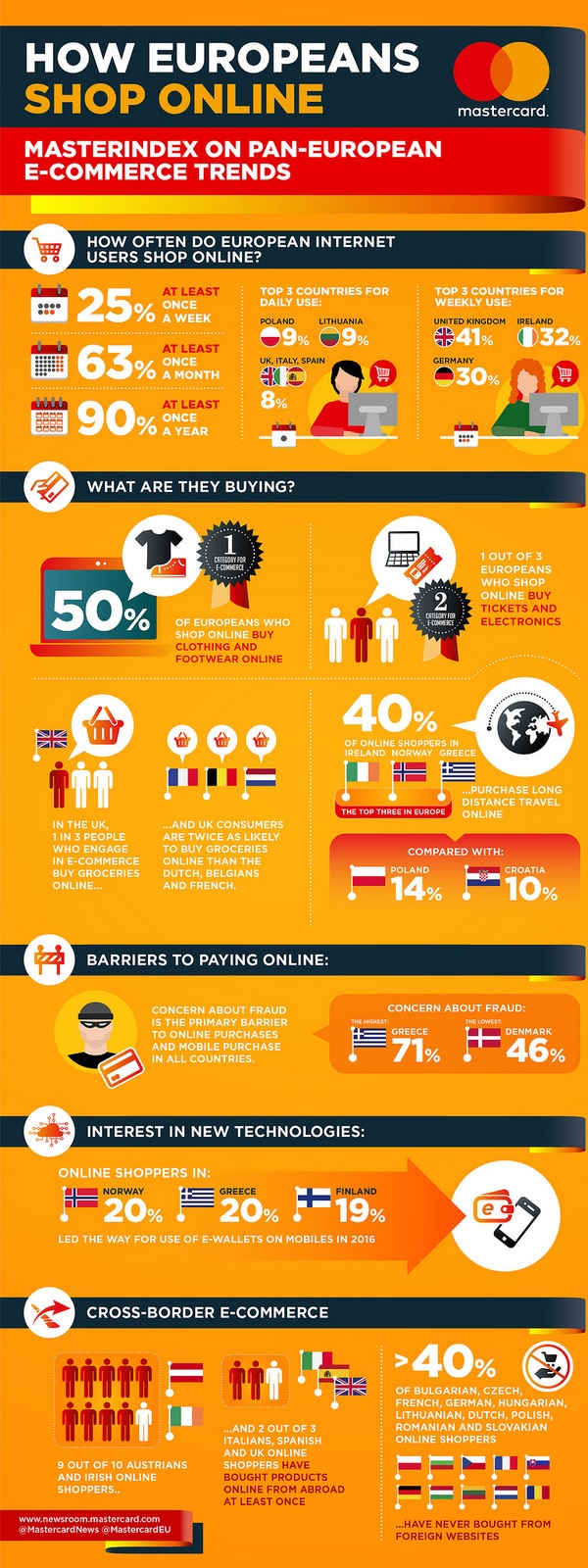MasterCard research: one in four European internet users shops online every week

Europeans are avid online shoppers according to the first Masterindex on pan-European e-commerce and new payment trends. With the European market for e-commerce expected to grow by 45% from 2015 to 2018[1], a Mastercard survey of consumers in over 20 countries in the European Economic Area (EEA) suggests that one in four Europeans with access to the internet purchased products or services online at least once a week in 2016.
While uptake of e-commerce is high across Europe, the research reveals interesting differences from country to country in terms of how often people shop online, what types of things they purchase, and their preferred payment methods. At a time when European policy makers are looking to break down barriers to cross-border e-commerce, the Masterindex highlights different national attitudes to buying from sites in other countries.
‘Our deep understanding of how people across Europe are embracing digital behaviours enables all of us at Mastercard to work with our partners across the region and build the products, solutions and technology that makes life that little bit more simple. In an increasingly complex and digital environment Mastercard is building the solutions that get us from to-do, to done in a way that doesn’t compromise on efficiency and security’, says Javier Perez, President, Mastercard Europe.
How often are people shopping online? UK internet users come out as the most regular users of e-commerce in Europe overall. The percentage of Poles (9%), Lithuanians (9%) and Italians (8%) who shop online every day is similar to the UK (8%). However, Britons stand out when it comes to weekly activity (41%), followed by the Irish (32%) and Germans (30%). In contrast, Finns (17%), Estonians (16%) and Danes (16%) are far less likely to buy something on the internet at least once a week.
„Across Europe there is a significant increase in activity when comparing daily to weekly frequency. This may be due to the fact that the types of things people buy online are less likely to be “everyday items”. For example clothing and footwear is by far the most popular category overall (48% EEA average) followed by tickets (34%), electronics (33%) and books (31%).”, according to the press release.
However, what people buy most differs from country to country – sometimes with surprising results:
Britons who shop online (33%) are twice as likely to buy their groceries on the internet as their nearest continental neighbours in the Netherlands (16%), France (15%) and Belgium (13%);
Greek online shoppers are four times more open to booking long distance travel on the internet than their Balkan counterparts in Croatia;
But we do see a regional trend where Finland (31%), Sweden (22%) and Norway (22%) are the only countries with more than one in five online shoppers engaging in online gambling.
Attitudes also vary on preferred methods of buying online. In the Czech Republic, Germany, Netherlands and Poland online banking is twice as popular as cards. But in countries such as the UK, France, Spain, Ireland and Italy, cards remain the most popular payment methods by some distance.
The survey also looked at new payment methods such as e-wallets, banking apps and QR code scanning – indicating strong potential for growth in these areas. While there is a clear openness across Europe to try out new technologies, this interest does not always correlate with actual use. For example while Spanish internet shoppers are the most enthusiastic about e-wallets in theory, they lag behind Norwegians (20%), Greeks (20%) and Finns (19%) when it comes to current mobile use of this technology.
Despite different trends from country to country, people across Europe tend to share similar concerns about online shopping. Fear of fraud is the number one reason for not buying online in all countries surveyed. Nevertheless, it acts as a greater barrier in some countries – e.g. Greece (71%) and Spain (64%) – than others e.g. Denmark (46%).
When it comes to cross-border e-commerce, trust appears to be much more of an issue for some nationalities than others. French online shoppers who never buy from other countries are roughly twice as likely as Spanish and Italians to cite lack of trust in foreign websites as their justification and four times more likely than Poles or Czechs.
In general, however, the main reason for not shopping online across borders is not trust or security concerns, but rather the availability of good domestic options. The survey shows that 40% of online shoppers in Finland, and Poland who do not buy from abroad feel that e-commerce sites in their country meet their requirements, with similar perceptions in the UK, France and Germany.
And when people do decide to look beyond their own country it is more likely as a result of an appealing offer (40%), than simply a question of availability (32%). The most popular items purchased cross-border are clothing, accessories and footwear (37%) followed by books, music, DVDs and video games (21%).
How likely people are to ever avail of such offers differs considerably from country to country – regardless of size. On the one hand, more than two in five online shoppers in Bulgaria, Czech Republic, France, Germany, Hungary, Lithuania, the Netherlands, Poland, Romania and Slovakia say they have never bought something from a website in another country. In contrast, almost 90% of people who shop on the internet in Austria and Ireland claim to have bought products online from abroad at least once in their lifetime. The same goes for more than two out of three online shoppers in Italy, Spain and the UK.
The overall picture points to strong potential for cross-border e-commerce growth, with on average more than 40% of Europeans online shoppers already engaging in cross-border e-commerce at least once a year.
Among the key factors to delivering on growth, both cross-border and domestically, appear to be continued efforts to build trust and confidence in e-commerce, and, critically, ever improving online offers and conditions.
About the Research
The majority of the data for the Masterindex is compiled from Mastercard’s existing internal Global Consumer Tracker (GCT) which surveys payments trends in 23 EEA countries[2] on regular basis. The GCT survey is carried out though an online questionnaire via online research panels amongst respondents aged 18 to 64 years who either own a payment card or have a bank account. Sample sizes varied between countries between 855 and 3,439 with a total of 42,881 consumers surveyed across the 23 countries. Questions on frequency of online buying are asked to internet users in general. Answers to all other questions refer to people who have indicated that they shop online.
This is the first time that this data has been summarised for external purposes with a view to contributing insights to business and policy discussions on e-commerce.
To complement this data on domestic e-commerce trends the 2017 Masterindex also draws partly on open source data for 2015-2016 from the Google Consumer Barometer Survey, and looks at cross border e-commerce trends in 26 EEA countries[3].
The Consumer Barometer survey is conducted through online research panels, amongst online population who use at least one connected device (computer, tablet or smartphone) and purchased at least one product online in last 3 to 12 months. The survey focuses on the adult population aged 16+ in each country. Frequency questions is asked to internet users in general, whereas other questions are asked to people who indicate whether or not they shop online cross-border.
It is important to note that this is a separate dataset to the GCT, which allow us to gain some insights into cross border trends. As of 2018, the intention is to extend the Global Consumer Tracker data set to cross-border e-commerce to ensure a single comparable dataset on trends in e-commerce in general and cross border e-commerce specifically.
Dariusz Mazurkiewicz – CEO at BLIK Polish Payment Standard
Banking 4.0 – „how was the experience for you”
„To be honest I think that Sinaia, your conference, is much better then Davos.”
Many more interesting quotes in the video below:










